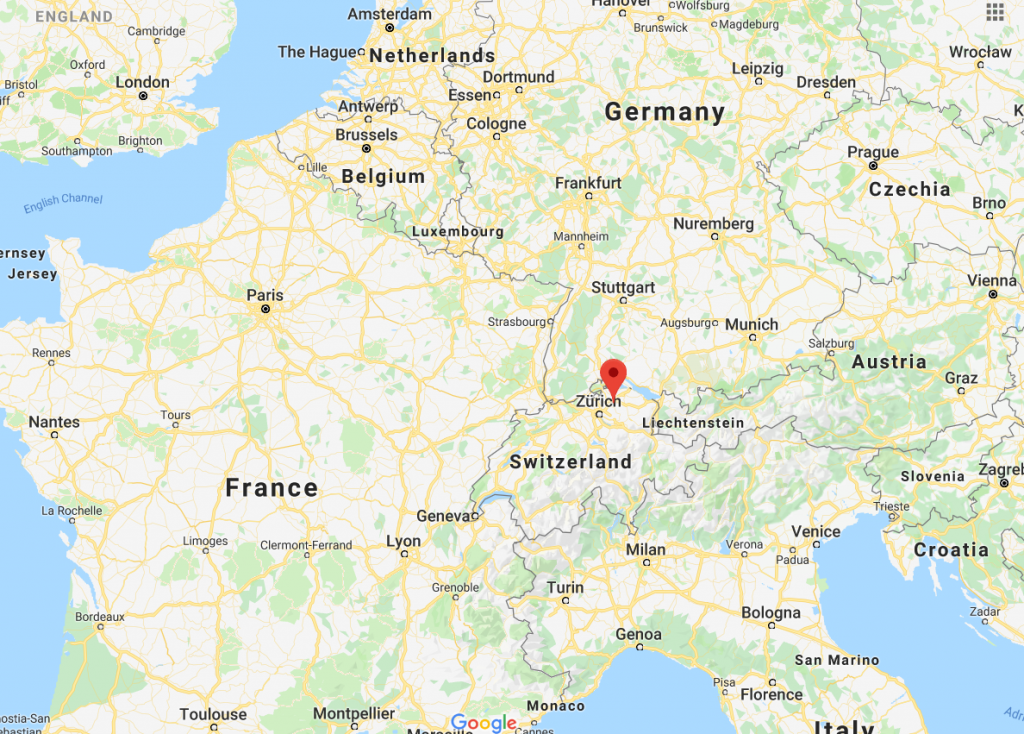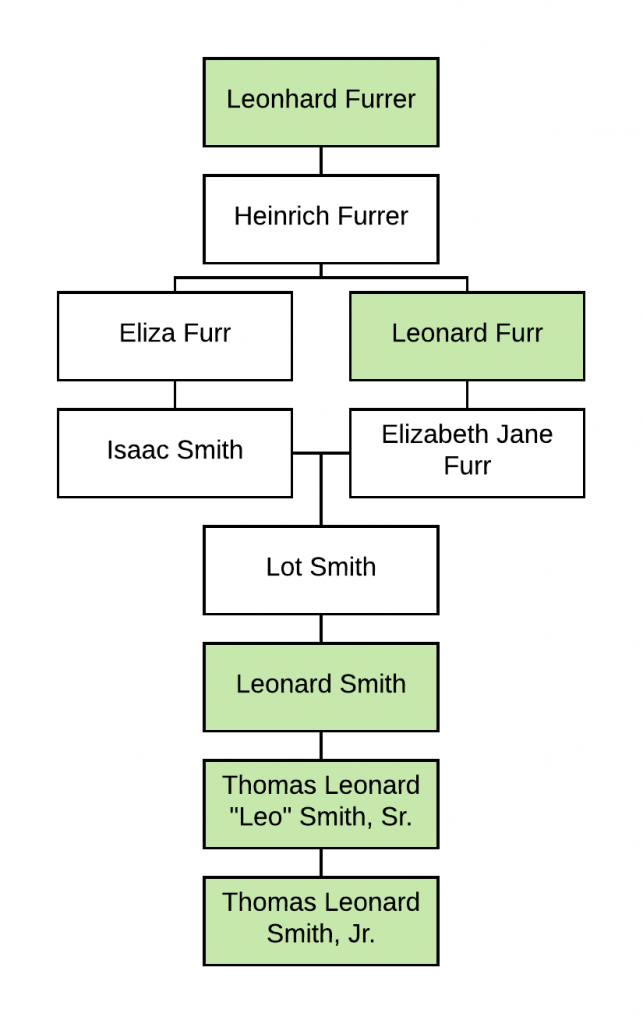This entry is part of the 52 Ancestors in 52 Weeks series. This week’s prompt is Namesake. To see other posts in this series, view my 52 Ancestors in 2019 index.
Does your family have any names that repeat for generations? In my Smith family, the given name Leonard appears again and again — and can be traced to my 7x-great-grandfather Leonhard Furrer.
Leonhard Furrer was born September 19, 1697, to parents Hans Jakob Furrer and Magdalena Schickli in Oberlangenhard/Zell, Switzerland.¹ The town is located in the district of Winterthur, canton of Zurich, in the northern part of Switzerland near its border with Germany.

(image from Google Maps)
Oberlangenhard/Zell has been an agricultural area for centuries,² so Leonhard was likely a farmer. Poor economic conditions in the early- to mid-18th century resulted in many families emigrating to Germany, and later to America.³ The official Swiss view of emigration was that leaving one’s county was a crime, as it deprived the homeland of a labor force and soldiers for defense.⁴ Only at the beginning of the 1700s were Swiss settlements encouraged in the Americas, but these relocations were of “undesirables” like paupers and religious minorities like Baptists, Anabaptists, and Mennonites.⁵ These emigrants established small Swiss communities in Pennsylvania and the Carolinas.⁶
In 1734, an edict was issued in Zurich that forbade emigration to Carolina.⁷ Would-be emigrants were prevented from selling their land, and later measures penalized them by taking away their citizenship and land rights forever.⁸ The government even imposed a 10-percent emigration tax, which caused some people to leave the country secretively.⁹ It was in this environment that Leonhard decided to leave Switzerland.
I do not know if Leonhard owned land or suffered any consequences for his decision, but he and his wife Babelj Zuppinger, along with sons Heinrich, age 11, and Hans Rudolf, age 1, set out for America in late 1738.¹⁰ They probably traveled the 100 kilometers to the city of Basel by foot or by wagon where they took a boat up the Rhine to Rotterdam, The Netherlands.¹¹ There, Leonhard and his family boarded the Jamaica Galley for their long ocean journey.¹²
The following excerpt from Pennsylvania Germans: A Persistent Minority explains the hardships of the voyage between Rotterdam and Pennsylvania:
Many who had never sailed before crowded the small vessels with poor sailors and rotten accommodations. They lived for six to eight weeks in cramped space on board, holding fast to the trunks, chests or baggage which contained all their worldly wealth. They were fortunate to find deck space.
Many of the families on their way to Pennsylvania were crowded onto ships that carried double the number of passengers the vessels could theoretically accommodate. In those cramped and crowded conditions, numerous passengers died at sea. So extensive was the list of casualties that ship captains finally settled upon a formula on how to avoid an excessive number of deaths which reduced their cargo. Occasionally fatalities also made them subject to quarantine regulations in the American ports. They agreed (and by the 1740s made it part of the verbal contract with prospective passengers) that the halfway point of the voyage was the critical time. If a passenger died before the vessel had traveled half the distance to Pennsylvania, then the captain would bear the expense and the corpse was reckoned as no fare. If, on the other hand a passenger died after the halfway point of the voyage, then his family must pay full fare to America, even though he was buried at sea.
The ocean passage required six weeks under favorable conditions, but even then preliminaries at Rotterdam and Cowes [England] added days or weeks to the voyage. Debarkation at Philadelphia was sometimes delayed because of wind and tide, or due to mercantile or port requirements and official red tape. Food consumption from the traveler’s own stock was apportioned for a six weeks’ crossing. When that was gone, they subsisted on meager rations from the ship’s stores, at inflated prices. Occasional suffering from storm delays or navigational miscalculations, as described above, affected both crew and passengers, but especially the latter.
Journey’s end caused loud celebrations and extended rejoicing among the weary passengers. Those who had, weeks earlier, given up all hope of ever reaching port, now offered up thanks to God for their safe arrival after their journey across “the very big sea.”¹³
Leonhard Furrer, age 40, appears on the list of men’s names arriving at the Port of Philadelphia aboard the Jamaica Galley on February 7, 1739.¹⁴ The list only contains the names of males age 16 or above, so Babelji and their sons are not recorded. Leonhard’s name also appears on the list of foreigners who swore an oath of allegiance to the Province of Pennsylvania that same day.¹⁵
No further records exist for Leonhard, Babelji, or Hans Rudolf; therefore, the remainder of my information is from oral tradition recorded by Robert Carol Furr in his book Our Story: A Short History of the Furr Family in America. Furr states Leonhard and family moved to Purrysburg, South Carolina, one of the independent Swiss settlements.¹⁶ The hot, humid climate and mosquitoes brought “the fever” to the settlement and wiped out the Furrer family — all except Heinrich.¹⁷ Heinrich survived the epidemic and went on to become the father of many Furr descendants in the Carolinas.¹⁸
Although only one of his sons survived, Leonhard’s name is the one that has continued in my family. Four generations of men carry his name:
- Leonard Furr¹⁹, grandson of Leonhard Furrer
- Leonard Smith (1843-1925)²⁰, 3x-great-grandson of Leonhard Furrer
- Thomas Leonard “Leo” Smith, Sr. (1882-1949)²¹, 4x-great-grandson of Leonhard Furrer
- Thomas Leonard Smith, Jr. (1917-2009)²², 5x-great-grandson of Leonhard Furrer
And because two first-cousin Furrs (Isaac Smith and Elizabeth Jane Furr) married in my line, Leonhard Furrer is my ancestor — and his namesake Leonards’ ancestor — twice:

in Smith Family Line
Did all these Leonards know the heritage of their name? Probably not. The story of our original Swiss immigrant Leonhard isn’t one that was passed down in our family history, but I’m pleased to have uncovered it in my research.
¹Charles Franklin Furr and Georges Segal, Ph.D., Furr Surname Resource Center (http://sites.rootsweb.com/~furr/ : accessed 7 Jun 2019), “Early Emigration from Switzerland to the American Colonies: The Family of Leonhard Furrer.”
²Municipal Administration Zell, Zell ZH Online (http://www.zell.ch/de/portrait/geschichte/ : accessed 7 Jun 2019), “History of the Municipality Zell.”
³Ibid.
⁴North Carolina Department of Natural and Cultural Resources, ANCHOR: A North Carolina History Online Resource (https://www.ncpedia.org/anchor/arrival-swiss-immigrants : accessed 7 Jun 2019), “The Arrival of Swiss Immigrants.”
⁵Ibid.
⁶Ibid.
⁷Ibid.
⁸Ibid.
⁹Ibid.
¹⁰Furr and Segal, Furr Surname Resource Center. “Early Emigration from Switzerland to the American Colonies: The Family of Leonhard Furrer.”
¹¹Ibid.
¹²Ibid.
¹³William T. Parsons, Pennsylvania Germans: A Persistent Minority (Collegeville, Pennsylvania: Chestnut Books, 1985), 47-50
¹⁴Ralph Beaver Strassburger and William John Hinke, editor, Pennsylvania German Pioneers: A Publication of Original Lists of Arrivals in the Port of Philadelphia from 1727 to 1808 (Baltimore: Genealogical Publishing Co., 1980), 1:251-253.
¹⁵Names of Foreigners Who Took the Oath of Allegiance to the Province and State of Pennsylvania, 1727-1775 (Baltimore: Genealogical Publishing Co., 1976), 181-182.
¹⁶Robert Carol Furr, Our Story: A Short History of the Furr Family in America (Montgomery, Alabama: self-published, 1994).
¹⁷Ibid.
¹⁸Ancestry, Find A Grave, database with images (https://www.findagrave.com/memorial/100140130/heinrich-furrer : accessed 31 May 2019), memorial 100140130, Heinrich Furr Furrer (1727-1769), Furr Family Cemetery, Mount Pleasant, Cabarrus County, North Carolina.
¹⁹1824 Births and Deaths, Lawrence County, Mississippi, “Mississippi, State and Territorial Census Collection, 1792-1866,” col. 2, line 37, Furr Leonard; image, Ancestry.com (https://www.ancestry.com/interactive/1125/v229_2-0351 : accessed 7 Jun 2019); citing HeritageQuest microfilm V229, roll 2.
²⁰Ancestry, Find A Grave, database with images (https://www.findagrave.com/memorial/33657327/leonard-smith : accessed 8 Mar 2019), memorial 33657327, Leonard Smith (1843-1925), Aimoch Cemetery, Nickel, LaSalle Parish, Louisiana.
²¹Ancestry, Find A Grave, database with images (https://www.findagrave.com/memorial/12939381/thomas-leonard-smith : accessed 14 Mar 2019), memorial 12939381, Thomas Leonard Smith, Sr. (1882-1949), Ogden Cemetery, Liddieville, Franklin Parish, Louisiana.
²²Ancestry, Find A Grave, database with images (https://www.findagrave.com/memorial/41546290/thomas-l_-smith : accessed 7 Jun 2019), memorial 41546290, Thomas L. Smith, Jr. (1917-2009), Greenwood Memorial Park, Pineville, Rapides Parish, Louisiana.

Another great article, Jessica !
Wonderful research and a story well-told. Future Leonards in your family will thank you for giving them this background on their name.
Thank you for sharing, particularly the excerpt from the book about the voyage conditions.